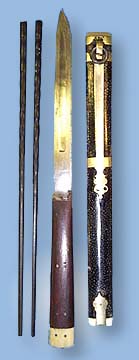

Chopsticks
were developed about 5,000 years ago in China. It is likely that people cooked
their food in large pots which retained heat well, and hasty eaters then broke
twigs off trees to retrieve the food. By 400 BCE, a large population and dwindling
resources forced people to conserve fuel. Food was chopped into small pieces
so it could be cooked more rapidly, thus needing less fuel.
|
CAS 0389-1935A-D: Japanese chopstick/ knife set |
|---|
 The
pieces of food were small enough that they negated the need for knives at the
dinner table, and chopsticks became staple utensils. It is also thought that Confucius,
a vegetarian, advised people not to use knives at the table because knives would
remind them of the slaughterhouse. Chinese chopsticks, called kuai-zi (quick little fellows), are usually 9 to 10 inches long and rectangular
with a blunt end. By 500 CE, chopstick use had spread from China to present-day
Vietnam, Korea, and Japan. The chopsticks to the left, while Japanese, are rectangular
in the Chinese style.
The
pieces of food were small enough that they negated the need for knives at the
dinner table, and chopsticks became staple utensils. It is also thought that Confucius,
a vegetarian, advised people not to use knives at the table because knives would
remind them of the slaughterhouse. Chinese chopsticks, called kuai-zi (quick little fellows), are usually 9 to 10 inches long and rectangular
with a blunt end. By 500 CE, chopstick use had spread from China to present-day
Vietnam, Korea, and Japan. The chopsticks to the left, while Japanese, are rectangular
in the Chinese style.
In Japan, chopsticks were originally considered precious and were used exclusively for religious ceremonies. The earliest chopsticks used for eating looked like tweezers; they were made from one piece of bamboo that was joined at the top. By the 10th Century, chopsticks were being produced in two separate pieces.
Japanese chopsticks differed in design from Chinese chopsticks in that they were rounded and came to a point; they were also shorter (7 inches long for females and 8 inches long for males).
The
Japanese usually made their chopsticks out of wood. To the lower right are chopsticks
with a characteristic Japanese style. Starting in the 17th Century, they were
the first to lacquer these wooden chopsticks, making them slippery but usable.
The Japanese were also the first to create disposable wooden chopsticks (called
wari-bashi),
which appeared in 1878.
Traditionally, chopsticks have been made from a variety of materials. Bamboo has been the most popular because it is inexpensive, readily available, easy to split, resistant to heat, and has no perceptible odor or taste. Cedar, sandalwood, teak, pine, and bone have also been used. The wealthy, however, often had chopsticks made from jade, gold, bronze, brass, agate, coral, ivory, and silver. In fact, during dynastic times it was thought that silver chopsticks would turn black if they came into contact with poisoned food. It is now known that silver has no reaction to arsenic or cyanide, but if rotten eggs, onion, or garlic are used, the hydrogen sulfide they release might cause these chopsticks to change color.
CAS 0389-1939A-D: Japanese chopstick/ knife set